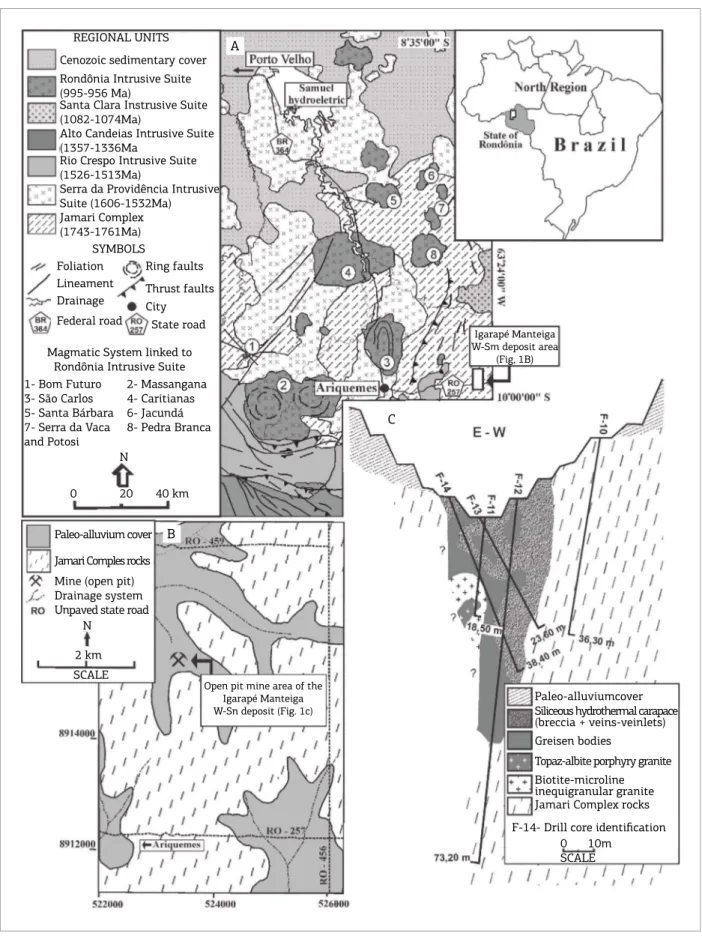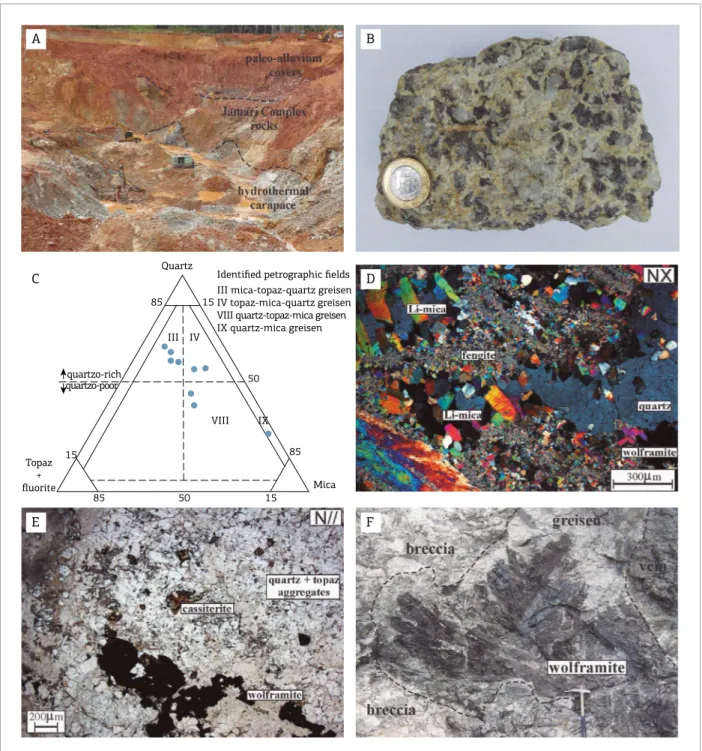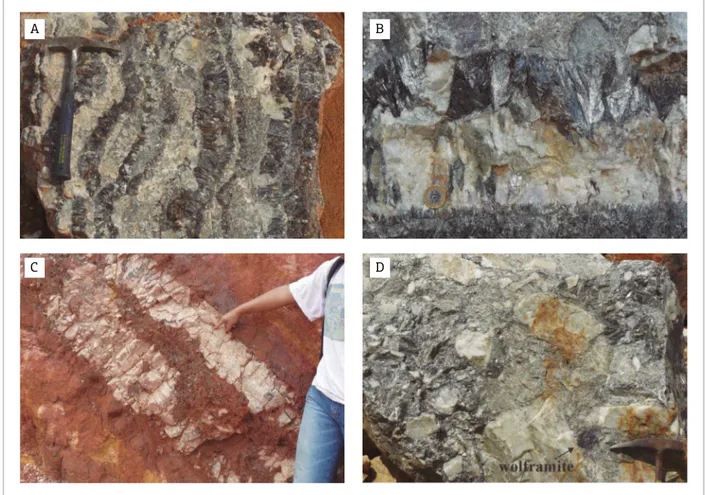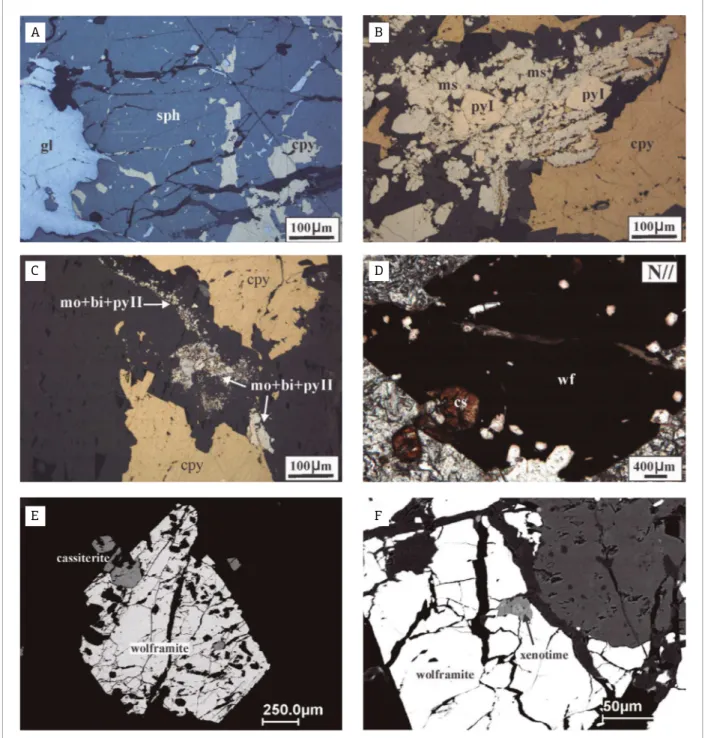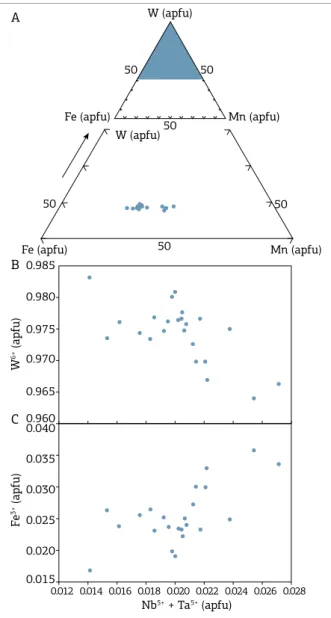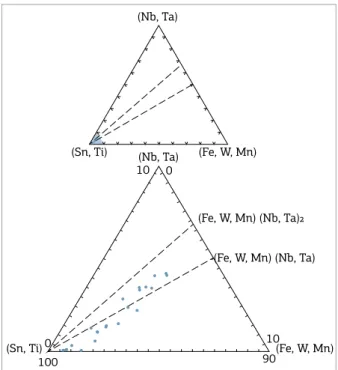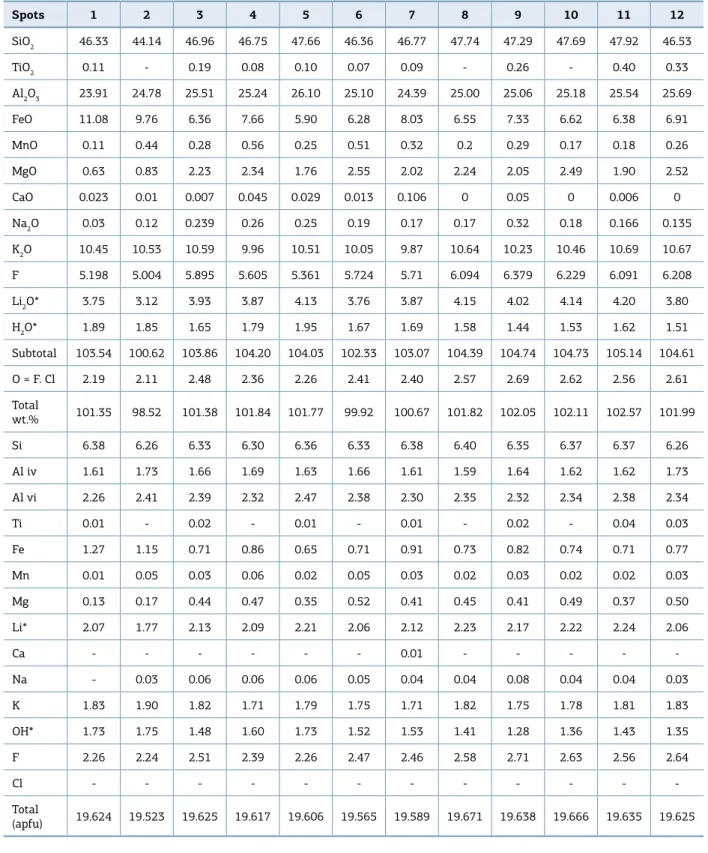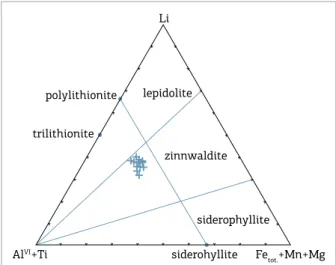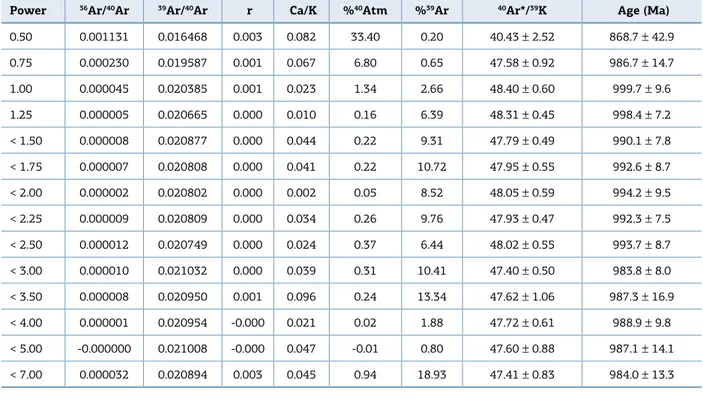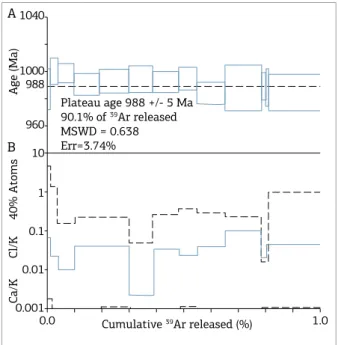1Geosciences Postgraduate Program, Universidade Federal do Amazonas – UFAM, Manaus (AM), Brazil. E-mail: thais.marcela@gmail.com 2Geosciences Institute, Universidade de Brasília – IG-UnB, Brasília (DF), Brazil. E-mail: valmirsouzaunb@gmail.com
*Corresponding author
Manuscript ID: 20170068. Received on: 05/08/2017. Approved on: 08/23/2017. ABSTRACT: he Igarapé Manteiga W-Sn deposit is formed by a granite stock that intrudes in the Paleoproterozoic basement. he mineralization is encapsulated in an alumino-siliceous hydrothermal carapace formed by greisen, vein-veinlets and breccia, developed in the apex zone of a granite stock. At this site, wolframite, cassiterite and sulides-minerals, as well as siderite, monazite, xenotime, he-matite and others, are spread out or in massive clusters associated with quartz, topaz, zinnwaldite and luorite. Wolframite is not zo-ned and relatively rich in Fe, and poor in Nb and Ta. Cassiterite exhibits growth-zones with light-yellow to dark-orange colors, and is rich in Ta, and poor in Ti, W, Mn and U. Oxygen and sulfur (δ18O and δ34S) isotope data on the ore- and sulide-minerals indicates that it is a magmatic source, with closing temperatures from 230°C to 480°C. he hydrothermal phase was cyclical and protractedly active, promoting greisenization and hydrofracturing. he lowering of tem-perature and the change in the composition of luids (from oxidized to reduced) controlled the precipitation of the hydrothermal mineral assemblage. he 40Ar-39Ar analyses reveal a plateau age of 988 Ma, interpreted as the closure time for the hydrothermal processes res-ponsible for mineralization, which is linked to the inal magmatic evolution of the Rondônia Intrusive Suite (995-991 Ma).
KEYWORDS: Rondônia Tin Province; Igarapé Manteiga W-Sn deposit; 40Ar-39Ar geochronology; Stable isotope; Mineralogy.
RESUMO: O depósito de W-Sn Igarapé Manteiga é formado por um stock granítico intrusivo no embasamento Paleoproterozóico. A mineral-ização está encapsulada em uma carapaça hidrotermal alumino-silicosa formada por greisen, veios-vênulas e brecha, desenvolvidos na zona apical do stock granítico. Os minerais de minério (wolframita ± cassiterita) e minerais sulfetados, bem como siderita, monazita, xenotima, hematita e outros, ocorrem disseminados ou em aglomerados maciços associados com quartzo, topázio, zinnwaldita e luorita. A wolframita não está zonada, é relativamente rica em Fe, pobre em Nb e Ta, enquanto a cassiterita exibe zonas de crescimento com cores de amarelo claro a laranja escuro, sendo rica em Ta, pobre em Ti, W, Mn e U. Dados de isótopos de oxigênio e enxofre (δ18O e δ34S) do minério e alguns sulfetos indicam uma fonte magmática, com temperatura de fechamento de 230° a 480°C. A fase hi-drotermal foi cíclica e prolongadamente ativa, promovendo greisenização e hidrofraturamento. A diminuição da temperatura e a alteração na com-posição dos luidos (de oxidado para reduzido), controlou a precipitação da associação mineral hidrotermal. Análises 40Ar-39Ar revelaram uma idade platô de 988 Ma, interpretada como fechamento do processo hidrotermal responsável pela mineralização, o qual está vinculado à evolução mag-mática inal da Suíte Intrusiva de Rondônia (995-991 Ma).
PALAVRAS-CHAVE: Província Estanífera de Rondônia; Depósito de W-Sn Igarapé Manteiga; Geocronologia 40Ar-39Ar; Isótopos estáveis; Mineralogia.
Mineralogy, stable isotopes (
δ
18
O and
δ
34
S)
and
40
Ar-
39
Ar geochronology studies on
the hydrothermal carapace of the Igarapé
Manteiga W-Sn Deposit, Rondônia
Estudos de mineralogia, isótopos estáveis (
δ
18O e
δ
34S) e
geocronologia
40Ar-
39Ar sobre a carapaça hidrotermal do
depósito de W-Sn Igarapé Manteiga, Rondônia
Thais Marcela Fernandes do Nascimento1, Valmir da Silva Souza1,2*
INTRODUCTION
he State of Rondônia, located on the SW border of the Amazonian Craton in Brazil, hosts several Meso- to Neoproterozoic rapakivi granitic associations, which form the Rondônia Tin Province. hese granitic suites have A-type and within-plate to post-collisional geochemical signatures, which were emplaced during successive magmatic episodes that occurred between 1606 and 974 Ma (Kloosterman
1968, Priem et al. 1966, 1971, Leal et al. 1978, Isotta et al.
1978, Bettencourt et al. 1999, CPRM 2007). However, the
most signiicant metal concentrations (Sn, W, Nb, Ta), as well as F and gemstones, are associated with the last three magmatic episodes that occurred between 1314 and 974 Ma, which are represented by regional units known as the São Lourenço-Caripunas (1314-1309 Ma), Santa Clara (1082-1074 Ma), and Rondônia (995-991 Ma) intrusive suites.
The mineralized sites are distributed mostly in the north-central part of the Rondônia Tin Province and are associated with the Rondônia intrusive suite (Fig. 1). hey occupy the apex zone of polyphasic magmatic sys-tems that are linked to late- to post-magmatic hydrothermal phases, encapsulated in hydrothermal carapaces formed by greisen, veins, breccia and pegmatite bodies (Leite Jr. 2002,
Souza 2003, Sparrenberger 2003, Bettencourt et al. 2005a).
However, important mineralized sites also occur in paleo-placer deposits, which have been exploited through a type of artisanal mining known as “garimpo” in Brazil.
he magmatic system of the Igarapé Manteiga W-Sn deposit is linked to the Rondônia intrusive suite (Nascimento 2010). his deposit was discovered in the early 2000s and during 2003-2008, it produced around 5,000 tons/ore (70% wolframite and 30% cassiterite). his mineralization is asso-ciated with greisen, vein-veinlets and breccia, but import-ant metal concentrations are also present in paleo-alluvial deposits. However, the 2008 global economic crisis has paralyzed metal extraction. Currently, the METALMIG Mining Company holds the mining rights and is seeking negotiations in order to reopen the mine.
Despite the knowledge gained about tin and other metal
deposits in Rondônia (Yokoi et al. 1987, Leite Jr. 2002, Souza
2003, Sparrenberger 2003, Bettencourt et al. 2005a, Santos
Jr. 2015), investigations into the chemical composition, the stable isotopes and the contents of the luid inclusions in the ore minerals, are still limited. he present paper describes
the textural relationships, the chemical and isotopic (δ18O
and δ34S) composition, and the age of the 40Ar-39Ar on the
mineralogical association found in the hydrothermal cara-pace zone of the Igarapé Manteiga W-Sn deposit. hus, this work aims to characterize substitution mechanisms, chem-ical and zoning patterns, as well as source and temperature
information on these minerals, in order to aid in the under-standing of the metallogenic processes that occurred in the north-central part of the Rondônia Tin Province.
METHODS
he conventional petrography was carried out at the Federal University of Amazonas, while the electron microscopy investigation was carried out at the Emílio Goeldi Paraense museum in Brazil, under the supervision of Professor H. T. Costi. A LEO 1450 VP model electron microscope was used on the polished rock sections studied, which were covered by a gold ilm. his microscope is equipped with a high-perfor-mance Gresham EDS/SDD spectrometer system. Mineral imaging was done by acquiring the mixed signal of back-scattered (BSE) and transmitted (TE) electrons. he elec-trons spectra are acquired at a working distance of 10 mm for 10-20 s of clock time. he probe sizes varied between 0.1-0.2 nm and had a beam current of 400-500 pA° and an accelerating voltage of 20 kV. All samples were screened for distinctive features before an automated particle anal-ysis (software EDAX/AMETEK Genesis) was performed.
he chemical-mineral analyses were performed using elec-tron probe microanalysis techniques (EPMA) with a JXA-8230 model JEOL superprobe at the Geoscience Institute of the University of Brasília in Brazil, under the supervi-sion of Professor N. F. Botelho. he conditions applied to each analysis point were an accelerating voltage of 20 kV, a beam current of 40 nA°, a beam diameter of 1-2 µm and a counting time of 15 s for peak and 10 s for background. Speciic standards were applied for the analysis of wolfram-ite, cassiterite and micas.
The stable isotope (δ18O) study was carried out at
the Isotope Geoscience Units of the Scottish Universities Environmental Research Centre Laboratories in Glasgow, Scotland, under the supervision of Professor A. E. Fallick. he nearly pure crystals samples were handpicked from selected specimens from the greisen. he oxygen isotope analyses were applied on cassiterite, wolframite, quartz and mica. Approximately 1 mg of oxygen bearing samples reacted
with chlorine triluoride (ClF3) using laser heating
luorina-tion techniques (Fallick et al. 1993, Macaulay et al. 2000).
he precision of determinations from laboratory replicate
analysis is 0.2‰ for δ18O relative to Vienna Standard Mean
Ocean Water (V-SMOW).
On the other hand, the sulfur isotope analyses (δ34S)
were carried out at isotopic geology laboratories of the Geosciences Institute of the University of Brasília in Brazil,
under the supervision of Professor B. M. Buhn (in
2- Massangana 4- Caritianas 6- Jacundá 8- Pedra Branca
F-14- Drill core identification
0 10m SCALE 1- Bom Futuro
3- São Carlos 5- Santa Bárbara 7- Serra da Vaca and Potosi
Paleo-alluvium cover
Jamari Comples rocks
Mine (open pit) Drainage system Unpaved state road
N
N
0 20 40 km
2 km SCALE
REGIONAL UNITS
A
Cenozoic sedimentary cover
Igarapé Manteiga W-Sm deposit area
(Fig, 1B)
Open pit mine area of the Igarapé Manteiga W-Sn deposit (Fig. 1c)
Rondônia Intrusive Suite (995-956 Ma)
Santa Clara Instrusive Suite (1082-1074Ma)
Alto Candeias Intrusive Suite (1357-1336Ma
Rio Crespo Intrusive Suite (1526-1513Ma)
Serra da Providência Intrusive Suite (1606-1532Ma) Jamari Complex (1743-1761Ma)
SYMBOLS Foliation Lineament Drainage Federal road
Ring faults
Thrust faults
State road City
Magmatic System linked to Rondônia Intrusive Suite
Paleo-alluviumcover Siliceous hydrothermal carapace (breccia + veins-veinlets) Greisen bodies
Topaz-albite porphyry granite Biotite-microline inequigranular granite Jamari Complex rocks
C
B
Figure 1. Location of the Rondônia Tin Province. (A) Regional geological map and location of the Igarapé Manteiga
sphalerite and molybdenite) were also handpicked from the selected veins. he grains were mounted in epoxy blocks and polished to obtain a smooth surface. he sulfur iso-tope content was obtained by means of laser ablation mul-tiple-collector inductively coupled plasma mass spectrome-try (LA-MC-ICP-MS), applied to each analysis point under an accelerating voltage of 20 kV, according to the analytical
procedure described by Bender et al. (2007) and Silva et al.
(2011). he calibration to the internal standards (NBS123, IAEA-S1 and IAEA-S2) yielded an analytical precision of around 0.4%.
he 40Ar/39Ar isotopic analyses on mica samples from
greisen were carried out at the isotopic geology laboratories at Queen’s University in the Department of Geological Sciences & Geological Engineering in Ontario (Canada), under the supervision of Professor D. A. Archibald. Mineral samples
for 40Ar/39Ar analyses were obtained from hand samples that
were ground by mortar and pestle, followed by a hand-picked selection that was placed under a binocular microscope to
guarantee a high purity of mica lakes. 40Ar-39Ar isotopic
anal-ysis followed the analytical procedure described by Roddick (1983). he mineral concentrates were then irradiated for about 40 hours in a McMaster nuclear reactor. A speciic 8 W Lexel 3500 ion laser (Ar), a MAP216 mass spectrom-eter with a Baur-Signer source and a multicollector electron were employed. Ages and errors were corrected using the for-mulas proposed by Steiger and Jäger (1977) and Dalrymple
et al. (1981). he 40Ar-39Ar ages and errors shown represent
an analytical precision of 2 σ or 0.5%, matching plateau
variation form spectrum (McDougall & Harrison 1988). he ages obtained were referenced to the standard Hb3Gr (hornblende) from 1072 Ma (Roddick 1983).
REGIONAL GEOLOGICAL SETTING
he Paleoproterozoic basement in the north-central part of the Rondônia Tin Province is mainly represented by a
regional unit called the Jamari Complex (Isotta et al. 1978).
he Jamari Complex is formed by a variety of medium to high-grade gneisses of tonalitic-enderbitic or granodiorit-ic-charnoenderbitic compositions, maic orthogneisses, amphi-bolites and schist lenses. hese rocks are polydeformed and present U-Pb crystallization ages between 1.76 and 1.67 Ga. However, they are marked by regional tectonometamorphic events from 1.67-1.63, 1.33 to 1.32 and 1.2 to 1.1 Ga.
(Santos et al. 2000, 2008, Payolla et al. 2002, Tohver et al.
2005, Scandolara 2006, Souza et al. 2006, CPRM 2007,
Bettencourt et al. 2010, Scandolara et al. 2013).
In this region, the Rondônia Tin Province comprises several Meso- to Neoproterozoic rapakivi granite suites
(Fig. 1A), represented by the regional units called Serra da Providência (1606-1532 Ma), Rio Crespo (1526-1513 Ma), Alto Candeias (1357-1336 Ma), Santa Clara (1082-1074 Ma) and Rondônia (995-956 Ma) intrusive suites, respectively. In general, these granite suites are polyphasic stocks and batholiths with alkaline to subalkaline, metaluminous - per-aluminous geochemical characteristics, and an A-type intra-plate to post-collisional geochemical signature. hey are
locally deformed by shear zones (Souza et al. 1975, Leal et al.
1978, Bettencourt et al. 1999, 2006, 2010, CPRM 2007).
he Rondônia Intrusive Suite stands for having major min-eralized sites in the region. his unit is composed of amphi-bole–biotite and alkali–feldspar syenogranites, syenites and microsyenites, and some rare rocks such as topaz-Li–mica albite and topaz-quartz-feldspar porphyry granites (Souza
et al. 1975, Leal et al. 1978, Bettencourt et al. 1999, CPRM 2007). he primary mineralization (Sn, W, Nb, Ta) is linked to late- to post-magmatic hydrothermal phases, encapsulated in bodies of greisen, vein, breccia and pegmatite, associated with quartz, topaz, Li-F micas, luorite, siderite, sphalerite, pyrite, chalcopyrite, arsenopyrite, galena, pyrrhotite, digen-ite-chalcocite, hematite, molybdenite, bismuthinite, monazite, thorite and others (Leite Jr. 2002, Souza 2003, Sparrenberger
2003, Bettencourt et al. 2005a, Nascimento 2010, Santos Jr.
2015). he available geochronological data on the timing of mineralization in the Rondônia Tin Province indicate that these late- to post-magmatic hydrothermal processes are very close to the ages of the late-stage rapakivi magmatic phases (Tab. 1). hese data suggest that the metal-enriched hydrothermal phases were exsolved from the NYF (Nb>Y(REE)-F) ailia-tion magmatic phase during the inal crystallizaailia-tion process (Lehmann 1982, Hedenquist & Lowenstern 1994, Burnham 1997, Černý & Ercit 2005, Richards 2011).
LOCAL GEOLOGICAL SETTING
he Paleoproterozoic Jamari Complex is composed of ortho- and paragneiss, charnockites and amphibolite lentic-ular bodies. In general, these rocks exhibit medium to coarse grained texture, as well as a pronounced metamorphic foli-ation with a northeast-southwest trend and high (75°-85°) dips to the southeast. Often these rocks are crossed by fault and ductile shear zones with mylonitic texture generation (Nascimento 2010).
In the magmatic system, the biotite-microcline gran-ite is pink in color, displays inequigranular medium- to coarse-grained texture and isotropic fabric. It is composed of
microcline (35-38%), quartz (25-27%), plagioclase (An18-24,
20-22%) and biotite (2-5%). he accessory minerals are zir-con, apatite, luorite, traces of monazite, pyrite and chal-copyrite. Chlorite, epidote, white mica and Fe-hydroxides are secondary minerals. On the other hand, the topaz-albite granite is light pink, displays inequigranular to porphyritic ine- to medium-grained texture and isotropic fabric. It is composed of quartz and microcline microperthitic anhedral and subhedral phenocrysts with grain sizes between 1.5 and 3.5 mm, embedded in a matrix formed by crystals aggregates with sizes ranging from 0.2 to 0.6 mm. Its essential miner-als are microcline (15-18%), quartz (16-20%), plagioclase
(albite = An4-6 47-52%), topaz (8-12%) and mica (5-8%).
Its accessory minerals are luorite, carbonate, sphalerite, pyrite, chalcopyrite and traces of metamict zircon. Microcline and quartz phenocrysts contain frequent inclusions of albite laths arranged in a discontinuously rounded pattern. his textural feature is typically magmatic and is indicative of their crys-tallization from the late stage residual and highly fraction-ated granitic melts (Stemprok 1991, Schwartz 1992, Zhu
et al. 2001, Lenharo et al. 2003).
he mineralized hydrothermal carapace zone presents an irregular contour distributed along the contacts between the cupola of the granite stock and the rocks of the Jamari Complex. It has an essentially siliceous to alumino-sili-ceous composition and brings together greisen, breccia and vein-veinlets. In this site, W-Sn and other metals are spread out or in massive clusters associated with gangue minerals (quartz, topaz, Li-micas, luorite and others).
Finally, there is a thick alluvium sequence, categorized as a paleo-luvial clastic deposit (Nascimento 2010), which completely covers the Igarapé Manteiga W-Sn deposit. his sedimentary cover is formed by a centi to meter-scale stratal sequence, composed of laminated to trough lam-inae cycles of ine- to medium-grained conglomerates, sand
Table 1. Available geochronological data for the age of the mineralization in the Rondônia Tin Province.
Sn-W deposit Regional unit Method Mineral Rock type Age (Ma) References
Santa Bárbara
Rondônia Intrusive Suite
(995-956 Ma)
Ar-Ar
zinnwaldite zinnwaldite zinnwaldite muscovite
syenogranite albite granite bedded greisen
mica vein
990 ± 5
985 ± 4
959 ± 4
987 ± 1.9
Bettencourt et al.
(2005b)
K-Ar zinnwaldite greisen 961± 17 Leite Jr. et al.
(2001)
Bom Futuro
Ar-Ar zinnwaldite zinnwaldite
pegmatite quartz vein
994 ± 3
993 ± 3
Bettencourt et al.
(2005b)
K-Ar zinnwaldite quartz vein 969 ± 27 Leite Jr. et al.
(2001)
U-Th-Pb monazite greisen 997 ± 48 Souza et al. (2005)
Igarapé
Manteiga Ar-Ar zinnwaldite mica greisen 988 ± 5 This paper
Oriente Novo
Santa Clara Intrusive Suite (1082-1074 Ma)
K-Ar
zinnwaldite zinnwaldite zinnwaldite
greisen greisen quartz vein
1006 ± 17
981 ± 35
993 ± 16 Leite Jr. et al.
(2001)
Rio Branco zinnwaldite greisen 976 ± 30
Potosi Ar-Ar muscovite mica greisen 1053 ± 3 Bettencourt et al.
(2005b)
Oriente Novo K-Ar biotite greisen 993 ± 40 Priem et al. (1971)
Liberdade
São Lourenço-Caripunas Intrusive
Suite (1314-1309 Ma)
and clay, and constitutes part of a channel ill. Important wolframite and cassiterite concentrations in coarse-grained aggregates occur associated to basal conglomerates.
HYDROTHERMAL ZONE
At this site, pervasive greisen alterations are dominant, followed by breccia and vein-veinlets. Greisen has trun-cates and irregular or intercalated geological contacts with breccia bodies, while the vein-veinlets crosses all rock types (Paleoproterozoic basement, cupola granitic, greisen and breccia) in a complex and multiple arrangement. Below we present the main features and the mineralogical composi-tion of these hydrothermalized facies.
Greisen
Greisens are light green to light gray in color and have inequigranular medium- to coarse-grained texture and isotro-pic fabric (Fig. 2B). hey are essentially composed of quartz, topaz, flourite, fengite and Li-mica in diferent proportions. Accessory minerals include wolframite, cassiterite, sider-ite, monazsider-ite, xenotime, hematsider-ite, chalcopyrsider-ite, sphalersider-ite, pyrite, pyrrhotite, galena, bismuthinite and molybdenite.
Additionally, Pereira et al. (2008) still reported the presence
of some sulides and exotic Ag- and Bi-telluride minerals
(e.g. cervelleite = Ag4TeS).
On the basis of Kühne et al. (1972, in Stemprok 1987) mineralogical quantitative classiication proposed for grei-sen, we identiied four exogreisen petrographic types: mica-quartz greisen, the dominant type, followed by topaz-mica-quartz greisen, quartz-topaz-mica greisen and, rarely, quartz-mica greisen (Fig. 2C). However, the contact rela-tionships between these greisen varieties are not clear due to lack of exposure.
he essential mineral assemblage consists of euhedral to anhedral crystal aggregates, with grain sizes between 0.5 and 6 mm in inequigranular microtexture. Quartz and topaz aggregates are dominant and representative for the youngest minerals in the crystallization sequence of the studied greis-ens. he mica crystal aggregates are euhedral to subhedral, display grain sizes between 1 and 10 mm and pale-brown to orange-greenish pleochroism (Fig. 2D). Frequently, mica aggregates occur in a lamellar radiating manner associated with siderite anhedral and fengite aggregates. Flourite occurs as isolated subhedral crystals with grain sizes varying from 1 to 4 mm or in small interstitial aggregates (size < 1 mm) and disseminated in the quartz-topaz-mica assemblage.
he wolframite and cassiterite euhedral to subhedral crys-tals are spread out or occur in small aggregates, normally illing cavities associated with the essential mineralogy of greisens
(Fig. 2E). hey show grain size in a large range from 1 to about 30 mm and frequently display micro-fractures illed by chalcopyrite, pyrite and galena. However, occasionally
wolframite ± cassiterite may occur as anomalous euhedral
centimetric aggregate crystals (Fig. 2F).
Vein-Veinlets
hese represent a complex and interlaced set of subverti-cal tensile fractures/issures crossing greisen and breccia and extend to the basement rocks from within the granitic cupola. hey present varied thicknesses, inequigranular medium- to coarse-grained textures and isotropic fabrics, and are essen-tially composed of quartz-topaz-mica aggregates, but may contain luorite, siderite, hematite, ore- and sulide-miner-als. Frequently, vein-veinlets display successive asymmetri-cal crustiication, marked by growth of quartz, topaz and mica crystals from issure walls towards the center, forming a comb structure (Figs. 3A and 3B). Occasionally, in the central part of some thicker veins, dilated zones or sheeted cavities occur, which are partially to totally illed by ore- and sulide-minerals associated with euhedral Li-micas (Fig. 3C). According to Jensen and Bateman (1981), the reopen-ing processes of the issures, which permits further deposi-tion, generally causes successive crustiication. On the other hand, the cavity illing involves two separate processes: dila-tation/opening and deposition of the minerals. he two may operate almost simultaneously, but normally they are inde-pendent processes that are separated by an interval of time. hese features are diagnostic of an efective and protracted hydrothermal re-circulation convective process.
he continuing hydrothermal supplies that go into issures or cavities may lead to metasomatic replacement, by which new minerals replace earlier formed minerals. his process may lead to partial or total illing of openings, which conse-quently causes the luid low to be signiicantly constrained.
his increases the conined luid pressure (i.e. reservoir of
hydrothermal solutions) and favors subsequent hydraulic fracturing from the forceful luidal with the generation of new veins that cross the earlier veins (Phillips 1972, Guha
et al. 1983, Foxford et al. 2000, Liu et al. 2015).
Breccia
as fragments of ore minerals (wolframite and cassiterite) and some sulide mineral (pyrite, chalcopyrite, galena). hese fragments are immersed in a matrix composed by essential mineralogy from greisen. he interfragmental space is completely illed by quartz, topaz, Li-mica, luorite and siderite aggregates in various proportions, as well as
hematite, goethite, ore- and sulide minerals. Occasionally, in the matrix, irregular vugs occur, which are partially illed by quartz-luorite-mica and encrustational growth of pyrite. In general, the fabric is typically fragment-sup-ported, but locally occurs as matrix-supfragment-sup-ported, especially in the Li-mica rich portions.
Quartz
15
50
85
15 50
85 15 Topaz
+
fluorite
quartzo-rich
quartzo-poor
Mica
85
III IV
VIII IX
Identified petrographic fields III mica-topaz-quartz greisen IV topaz-mica-quartz greisen VIII quartz-topaz-mica greisen IX quartz-mica greisen
A B
C D
E F
Figure 2. (A) Open-pit mine area developed in the apex-zone of the Igarapé Manteiga granitic stock; (B) Macroscopic textural arrangement of the mica-topaz-quartz greisen; (C) Quantitative classiication of the Igarapé Manteiga
greisen, applying the diagram proposed by Kühne et al. (1972, in Stemprok 1987); (D) Microtexture of topaz-mica-quartz greisen (NX = crossed nicols); (E) Microtexture of quartz-topaz-mica greisen with wolframite and cassiterite disseminated crystals (N// = parallel nicols); (F) Wolframite large crystals developed in greisen. Observe
Based on the studies of Laznicka (1989) and Jébrak (1997), these breccia bodies can be classiied as hydrother-mal, and originate from efective luidal pressure beneath a siliceous to alumino-siliceous hydrothermal carapace that led to fracture propagation, corrosive wear and hydrau-lic fragmentation. he ield observations suggest that this fragmentation process was cyclical and formed successive breccia bodies. According to Plimer (1987), the hydraulic fragmentation process can be repeated many times, result-ing in an extended sequence of breccia bodies and sheeted vein systems.
MINERALOGY
In this section, we present the petrographic features and chemical data on the sulide mineral assemblage, ore-miner-als (wolframite and cassiterite) and mica. his information helps to understand the mineral substitution mechanisms
and the zoning patterns in a hydrothermal environment. Additionally, the chemical study on mica from greisen aims
to support discussions of 40Ar-39Ar geochronological analysis.
Sulfide mineral assemblage
he sulide mineral assemblage in the greisen and veins showed petrographic texture diagnostics for a paragenetic sequence formation, which is probably linked to lowering temperature and physico-chemical changes (pressure, pH and Eh conditions) in the hydrothermal environment.
Sphalerite and pyrrhotite in anhedral to subhedral crystals have grain sizes between 30 and 90 µm, exhibit corroded bor-ders, probably because of mineral-luid interaction, as well as micro-inclusions of chalcopyrite, pyrite (I) and galena, mainly illing micro-fractures (Fig. 4A). Sphalerite and pyrrhotite rep-resent the earliest sulide-mineral phase at a high temperature (300-350°C) within hydrothermal environments exsolved from cooling and crystallizing granitic magmas (Yund & Hall 1969, Stanton 1972, Ohmoto & Rye 1979, Barton & Skinner 1979).
A B
C D
he interstices between pyrrhotite and sphalerite crystals are frequently occupied by the subsequent sulide-mineral phase, probably at a moderate temperature (300-250°C), formed by chalcopyrite, pyrite (I) and galena anhedric aggregates (Ohmoto & Lasaga 1982, Vaughan & Craig 1997).
Sometimes, there are pyrrhotite crystals with corroded borders that are partially replaced by pyrite (II) anhedral and subhedral aggregates. Generally, this replacement reaction involves the dissolution of the pyrrhotite immediately fol-lowed by the precipitation of the pyrite (Murowchic 1992,
A B
C D
E F
Vaughan & Craig 1997, Qian et al. 2011). he monoclinic
pyrrothite ± pyrite association, under a hydrothermal
envi-ronment, is stable between 220 and 250°C (Stanton 1972,
Kissin & Scott 1982, Qian et al. 2011, Chareev et al. 2014).
Additionally, isometric pyrite (I) is partially replaced by orthorhombic marcasite (Fig. 4B). his is a polymorphic replacement that occurs mainly due to the lowering of the temperature and under delicate physico-chemical conditions
(i.e. pH < 5, T ≤ 250°C), as well as from efective actions
of the H2S2-hydrothermal solution (Murowchick & Barnes
1986, Murowchick 1992).
Finally, the last sulide-mineral phase recognized is com-posed of a bismuthinite, molybdenite and pyrite II assemblage. Generally, these minerals have euhedral to subhedral shapes, measure less than 30 µm and occur in interstices between grains or forming illets encrusted on the borders of preterit sulide-minerals, as well as illing micro-issures (Fig. 4C). However, studies are contradictory about the temperature of bismuthinite and molybdenite solubility and precipitation under hydrothermal conditions (Wood & Samson 1998, Seward & Branes 1997). he mode of occurrence (interstitial or in illets encrusted), as well as the presence of Ag-sulides and tellurides, can be indicative of low temperature (T <
250°C) conditions (Wood et al. 1987, Vaughan & Craig
1997, Seward & Branes 1997). Additionally, the presence of pyrite (II) euhedral crystals may also indicate the action of successive S-supply or an excess of sulfur consumption present in the lower temperature residual hydrothermal solution (Vaughan & Craig 1997, Seward & Barnes 1997).
Wolframite
he opaque crystals of wolframite normally occur in association with cassiterite crystals. They are fractured and apparently clean (Figs. 4D and 4E). However, elec-tron microscopy investigations reveal the presence of some micro-inclusions of monazite, xenotime and Nb-Ta-Fe oxide minerals (Fig. 4F).
Wolframite [(Fe, Mn)WO4] is the intermediate member
of a complete solid-solution, which has ferberite (FeWO4) and
hübnerite (MnWO4) as end members (Hsu 1976, Waychunas
1991). he microprobe analyses on the wolframite crystals show a tendency of ferberite, whose FeO (total) content is about two times greater than the MnO content, while the
Nb2O5 + Ta2O5 content is around 1 wt.% (Tab. 2). In the
W vs Fe vs Mn atomic concentrations triangular diagram,
the tendency is also observed of analytical results moving to the iron vertex (Fig. 5A). In general, the analytical results point to a chemical structural formula that can be expressed
as (Fe0.61-0.71 Mn0.32-0.42)WO4. hese results are also
consis-tent with the data available for the Bom Futuro tin deposit in the Rondônia Tin Province (Souza & Botelho 2009).
he wolframite crystals show some Nb and Ta impurities, most likely resulting from coupled substitution, according
to the following equation: Fe2+ + W6+ ↔ Fe3+ + (Nb,Ta)5+
(Polya 1988). his substitution may be favored by a relative
decrease in W6+ in conjunction with the increase in Nb5+
+ Ta5+ (Fig. 5B), with the electrostatic charge deiciency
resulting from this substitution being compensated by the
oxidation from Fe2+ to F3+, as diagnosed by the diagram of
atomic correlation Fe3+calc. vs Nb5+ + Ta5+ (Fig. 5C). Due to
the low content of Ta (Tab. 2), this element probably joint Nb as a participate in a coupled substitution (Neiva 2008).
Wolframite analyses have the highest calculated Fe2+ values
(Tab. 2), which suggests that they precipitated from reduced hydrothermal luids.
According to Hsu (1976) and Ivanova (1988), the fer-berite member is stable under oxidizing conditions and temperatures above 400°C. herefore, it is possible that the Nb-Ta-Fe oxide minerals included in wolframite are exso-lution generated during the lowering of the temperature.
Cassiterite
he crystals of cassiterite exhibit irregular and discontin-uous growth-zones, whose colors range from light-yellow to dark-orange (Fig. 4D). hey contain between 91.18-98.25
wt.% SnO2, 0.30-2.52 wt.% FeOtotal, 0-1 wt.% Nb2O3, 0-4
wt.% Ta2O3, and very low concentrations of Ti, W, Mn and
U impurities (Tab. 2). he Ta2O3 contents can be
consid-ered relatively high for cassiterite, which is usually below 2 wt.% (Neiva 1996, 2008, Souza & Botelho 2009, Costi
et al. 2000). he light-yellow growth-zones are nearly pure
SnO2, whereas the dark-orange ones have some FeO(total),
TiO2, Ta2O5, Nb2O5 and WO3 contents. hese results in
gen-eral are also consistent with the data available for the Bom Futuro tin deposit in the Rondônia Tin Province (Souza & Botelho 2009), as well as for other tin deposits (Giuliani
1987, Murciego et al. 1997).
he variations in cassiterite composition have been
dis-cussed by several authors (Neiva 1996, 2008, Murciego et al.
1997, Möller et al. 1998). According to these authors, the
main mechanisms are replacements of Sn by Fe + Ti impu-rities, attributed to the change in composition of hydrother-mal luids with decreasing temperature, and controlled by the Equations 1 and 2:
2Sn4+ + O2+↔ Ti4+ + Fe3+ + OH- (1)
3(Sn, Ti)4+↔ 2(Nb,Ta)5+ + Fe2+ (2)
he analyses on the cassiterite crystals presented these replacement types, illustrated by the negative atomic
wolframite
Spots 1 2 3 4 5 6 7 8 9 10 11 12
WO3 75.04 73.97 73.95 74.88 74.71 74.57 74.36 75.40 74.99 75.80 75.79 76.14
SnO2 0.00 0.00 0.00 0.00 0.00 0.00 0.00 0.01 0.00 0.00 0.00 0.00
TiO2 0.00 0.03 0.00 0.01 0.00 0.00 0.00 0.06 0.01 0.00 0.01 0.02
CaO 0.01 0.00 0.02 0.01 0.00 0.00 0.27 0.02 0.00 0.00 0.00 0.02
Nb2O3 0.73 0.54 0.75 0.74 0.96 0.61 1.01 0.81 0.59 0.68 0.76 0.51
Ta2O3 0.36 0.20 0.36 0.38 0.40 0.31 0.17 0.22 0.20 0.23 0.18 0.18
FeO(tot.) 15.61 16.77 15.51 15.64 16.23 14.53 15.73 15.65 15.51 15.62 15.17 15.18
MnO 9.11 7.57 9.07 8.95 8.40 9.87 8.76 8.80 8.89 8.85 8.87 8.99
Total (wt.%) 100.86 99.08 99.66 100.61 100.70 99.89 100.30 100.97 100.19 101.18 100.78 101.04
W 0.970 0.974 0.967 0.970 0.966 0.974 0.964 0.973 0.976 0.977 0.980 0.983
Sn 0.000 0.000 0.000 0.000 0.000 0.000 0.000 0.000 0.000 0.000 0.000 0.000
Ti 0.000 0.001 0.000 0.001 0.000 0.000 0.000 0.002 0.001 0.000 0.001 0.001
Ca 0.001 0.000 0.001 0.001 0.000 0.000 0.015 0.001 0.000 0.000 0.000 0.001
Nb 0.016 0.012 0.017 0.017 0.022 0.014 0.023 0.018 0.013 0.015 0.017 0.012
Ta 0.005 0.003 0.005 0.005 0.005 0.004 0.002 0.003 0.003 0.003 0.003 0.003
Fe2+calc. 0.621 0.686 0.622 0.624 0.644 0.586 0.622 0.624 0.628 0.627 0.614 0.616
Fe3+calc. 0.030 0.026 0.033 0.030 0.034 0.026 0.036 0.027 0.024 0.023 0.020 0.017
Mn 0.385 0.326 0.388 0.379 0.355 0.421 0.371 0.371 0.378 0.373 0.375 0.380
Total (apfu) 2.028 2.028 2.033 2.027 2.026 2.025 2.033 2.019 2.023 2.018 2.010 2.012
wolframite
Spots 13 14 15 16 17 18 19 20 21 22 23
WO3 75.81 76.09 75.79 75.80 75.42 75.98 75.68 75.63 75.07 75.35 75.56
SnO2 0.00 0.00 0.00 0.00 0.00 0.00 0.00 0.00 0.00 0.00 0.00
TiO2 0.00 0.01 0.00 0.00 0.02 0.00 0.00 0.01 0.00 0.01 0.00
CaO 0.02 0.01 0.00 0.00 0.02 0.00 0.00 0.00 0.00 0.00 0.00
Nb2O3 0.71 0.72 0.74 0.76 0.83 0.77 0.70 0.78 0.60 0.82 0.70
Ta2O3 0.33 0.27 0.26 0.24 0.21 0.22 0.27 0.23 0.28 0.38 0.25
FeO(tot.) 15.51 15.22 15.34 15.30 15.21 15.40 15.37 15.36 15.58 15.27 15.45
MnO 8.92 8.83 9.06 9.08 8.91 8.94 9.03 9.00 8.95 8.89 9.11
Total (wt.%) 101.30 101.15 101.19 101.18 100.60 101.31 101.05 101.01 100.48 100.72 101.07
W 0.975 0.981 0.977 0.977 0.977 0.978 0.976 0.976 0.974 0.975 0.975
Sn 0.000 0.000 0.000 0.000 0.000 0.000 0.000 0.000 0.000 0.000 0.000
Ti 0.000 0.001 0.000 0.000 0.001 0.000 0.001 0.000 0.000 0.000 0.000
Ca 0.001 0.001 0.000 0.000 0.001 0.000 0.000 0.000 0.000 0.001 0.000
Nb 0.016 0.016 0.017 0.017 0.019 0.017 0.016 0.018 0.014 0.019 0.016
Ta 0.005 0.004 0.004 0.003 0.003 0.003 0.004 0.003 0.004 0.005 0.003
Fe2+calc. 0.618 0.614 0.614 0.613 0.612 0.617 0.616 0.616 0.627 0.613 0.618
Fe3+calc. 0.025 0.019 0.023 0.023 0.023 0.022 0.024 0.024 0.026 0.025 0.025
Mn 0.379 0.372 0.382 0.383 0.377 0.376 0.381 0.380 0.380 0.376 0.384
Total (apfu) 2.019 2.008 2.017 2.016 2.013 2.013 2.018 2.017 2.025 2.014 2.021
Table 2. Electron microprobe data on the chemical composition of the wolframite and cassiterite. Oxides in wt.% and element in atoms per formula unit (apfu). Cation formula calculated on four atoms of oxygen for wolframite and on two atoms of oxygen for cassiterite.
cassiterite
Spots 1 2 3 4 5 6 7 8 9 10 11 12
SnO2 91.18 91.28 90.85 91.61 92.53 91.20 92.57 92.67 94.24 93.72 94.49 95.30
TiO2 0.24 0.39 0.50 0.63 0.66 0.53 0.73 0.40 0.38 0.65 0.62 0.76
Nb2O3 2.09 0.99 1.02 0.75 0.87 0.97 0.87 0.93 0.74 0.60 0.59 0.33
Ta2O3 1.70 4.50 4.27 3.73 3.63 4.32 3.41 3.47 2.92 2.48 2.30 1.38
FeO(tot.) 2.52 1.43 1.38 1.27 1.11 1.20 1.07 1.08 0.89 1.00 1.07 0.66
WO3 1.25 0.25 0.28 0.87 0.29 0.24 0.16 0.14 0.08 0.42 0.62 0.68
MnO 0.21 0.01 0.07 0.09 0.06 0.02 0.04 0.00 0.00 0.02 0.13 0.05
UO2 0.00 0.03 0.00 0.03 0.00 0.00 0.00 0.00 0.00 0.00 0.00 0.00
Total (mol%) 99.19 98.88 98.37 98.98 99.15 98.48 98.85 98.69 99.25 98.89 99.82 99.16
Sn 0.911 0.922 0.920 0.929 0.929 0.923 0.931 0.937 0.947 0.943 0.942 0.955
Ti 0.005 0.007 0.010 0.012 0.012 0.010 0.014 0.007 0.007 0.012 0.012 0.014
Nb 0.024 0.011 0.012 0.009 0.010 0.011 0.010 0.011 0.008 0.007 0.007 0.004
Ta 0.012 0.031 0.030 0.026 0.025 0.030 0.023 0.024 0.020 0.017 0.016 0.009
Fe 0.053 0.030 0.030 0.027 0.023 0.025 0.023 0.023 0.019 0.021 0.022 0.014
W 0.008 0.002 0.002 0.001 0.002 0.002 0.001 0.001 0.001 0.003 0.004 0.004
Mn 0.004 0.000 0.002 0.002 0.001 0.001 0.001 0.000 0.000 0.000 0.003 0.001
U 0.000 0.001 0.000 0.001 0.000 0.000 0.000 0.000 0.000 0.000 0.000 0.000
Total (apfu) 1.017 1.004 1.006 1.007 1.003 1.002 1.003 1.002 1.002 1.003 1.006 1.001
cassiterite
Spots 13 14 15 16 17 18 19 20 21 22 23
SnO2 95.97 95.13 95.48 95.48 98.25 98.14 97.94 97.73 95.36 97.93 97.46
TiO2 0.70 1.23 1.23 0.80 0.12 0.16 0.05 0.11 0.49 0.05 0.07
Nb2O3 0.29 0.27 0.27 0.40 0.03 0.00 0.04 0.13 0.41 0.01 0.41
Ta2O3 1.38 1.11 1.08 1.36 0.07 0.04 0.03 0.23 1.52 0.01 0.12
FeO(tot.) 0.55 0.63 0.68 0.86 0.30 0.26 0.32 0.41 0.77 0.44 0.42
WO3 0.20 0.43 0.40 0.08 0.00 0.00 0.00 0.02 0.70 0.60 1.12
MnO 0.00 0.03 0.00 0.03 0.06 0.03 0.01 0.00 0.16 0.06 0.09
UO2 0.00 0.00 0.00 0.00 0.00 0.00 0.00 0.00 0.01 0.00 0.02
Total (mol%) 99.09 98.83 99.14 99.01 98.83 98.63 98.39 98.63 99.42 99.10 99.69
Sn 0.963 0.952 0.953 0.957 0.993 0.993 0.994 0.989 0.955 0.988 0.975
Ti 0.013 0.023 0.023 0.015 0.002 0.003 0.001 0.002 0.009 0.001 0.001
Nb 0.003 0.003 0.003 0.005 0.000 0.000 0.000 0.001 0.005 0.000 0.005
Ta 0.009 0.008 0.007 0.009 0.001 0.000 0.000 0.002 0.010 0.000 0.001
Fe 0.012 0.013 0.014 0.018 0.006 0.006 0.007 0.009 0.016 0.009 0.009
W 0.001 0.003 0.003 0.001 0.000 0.000 0.000 0.000 0.005 0.004 0.007
Mn 0.000 0.001 0.000 0.001 0.001 0.001 0.000 0.000 0.003 0.001 0.002
U 0.000 0.000 0.000 0.000 0.000 0.000 0.000 0.000 0.000 0.000 0.000
Total (apfu) 1.001 1.003 1.003 1.006 1.003 1.003 1.002 1.003 1.003 1.003 1.000
and 6B). Additionally, the W+Mn+Ti contents vary in proportion to the Fe contents (Fig. 6C), providing for the formation of a molecular wolframite species in the darker growth-zones, controlled by a type of coupled replacement, which can be described by Equation 3:
2(Sn, Ti)4+↔ (W, Mn)6+ + Fe2+ (3)
his can be illustrated by the negative atomic
correla-tion diagram Sn+Ti vs Fe+W+Mn (Fig. 6D).
hese data indicate that Equations (2) and (3) con-trolled the substitution mechanisms for Nb+Ta and W+Mn impurities in crystals of cassiterite, which are linked to Fe/Ti ratios in dark-orange growth-zones. his is strongly supported when the compositions of cassiterite crystals are
plotted in the (Nb,Ta) vs (Fe, W, Mn) vs (Sn, Ti) apfu
tri-angular composition diagram (Fig. 7). hey tend to align approximately along the (Sn,Ti) – (Fe,W,Mn)(Nb,Ta)
joint, indicating that the 3(Sn, Ti)4+ ↔ 2(Nb,Ta)5+ +
(Fe,W,Mn)2+ substitution mechanism is dominant. On the
other hand, Equation (1) controlled the coupled substitu-tion mechanisms of Sn by Fe+Ti in light-yellow growth-zones, which would have been responsible for the change in color of the cassiterite.
Mica
Normally the mica crystals exhibit a black to dark green color and occur as euhedral to subhedral book aggregates with wide variation sizes. In the greisen and breccia, the mica crystals have a size ranging from 1 to 10 mm, but in the dilated zone of some thicker veins, this size can reach around 5 cm and draw comb and radial arrangements. In general, in greisen petrography observations, the mica crystals display from yellowish-orange-green to bluish-light brown-purple pleochroism, show slightly undulous extinc-tion, and contain some Ti-Fe-hydroxide mineral inclusions. U-h mineral micro-inclusions are rarely observed in the development of pleochroic haloes.
he microprobe analyses of the mica crystals from quartz-topaz-mica greisen showed that they are triocta-hedral sheets (Tab. 3), based on a nomenclature proposed
by Rieder et al. (1998). hey have LiO2 = 3-4 wt.%, F =
5-6 wt.%, MgO < 3 wt.%, SiO2 = 44-48 wt.%, Al2O3 =
24-26 wt.% and FeO = 6-11 wt.%. On the Li vs AlVI+Ti vs
Fetot.+Mn+Mg triangular diagram, the analyses plot on the
zinnwaldite ield, with a composition near the midpoint of the polylithionite-siderophylite joint (Fig. 8). In gen-eral, these micas have similar chemical compositions to the other Li-Fe zinnwaldite from greisen, which is linked to evolved granitic systems of the Rondônia Intrusive Suite (Lowell & Ahl 2000, Leite Jr. 2002, Souza 2003). According to Lowell and Ahl (2000), Li-Fe zinnwaldite from greisens and veins linked to evolved granitic sys-tems from Rondônia were crystallized at temperatures around 500°C, with a pressure between 1-500 bar and
fO2 around 10-23.
STABLE ISOTOPE
In this section, we present data from stable isotopes (δ18O
and δ34S) obtained in the ore-minerals (wolframite and
cas-siterite), quartz and sulide-mineral assemblages from grei-sen and veins. hese data can provide information on the environment and crystallization temperature for the hydro-thermal mineral assemblage and mineralization.
0.012 0.014 0.016 0.018 0.020 0.022 0.024 0.026 0.028 A
B
C
W (apfu)
Fe (apfu) Mn (apfu) 50
50
50
50
50
50 W (apfu)
Fe (apfu) Mn (apfu)
W
6+ (apfu)
0.985
0.980
0.975
0.970
0.965
0.960
Fe
3+ (apfu)
0.040
0.035
0.030
0.025
0.020
0.015
Nb5+ + Ta5+ (apfu)
Figure 5. Atomic correlation diagrams (apfu) applied
to wolframite crystals. (A) W vs Fe vs Mn triangular
Oxygen Isotope (
δ
18O)
he oxygen isotope studies were focused on the ore minerals and applied the wolframite + quartz and cassit-erite + quartz pairs from greisen, which showed an appar-ent equilibrium in hydrothermal assemblage. he isotopic
results have a degree of uncertainty of ± 0.2‰, which are
in Table 4 and are discussed below.
Wolframite (δ18O = 0.6-0.9‰), cassiterite (δ18O =
1.6-1.8‰) and quartz (δ18O = 9.1-9.7‰) have revealed subtle
variations in the respective oxygen isotope compositions, which indicate relative isotopic equilibrium with a common
luid. he diferent δ18O values for wolframite, cassiterite
and quartz are indicative of isotopic fractionation during the rise of the hydrothermal luid and consequent mineral
crystallization. Low values of δ18O (from 0‰ to 10‰)
are recorded in many Sn-W hydrothermal deposits and are interpreted as a consequence of the mixing between isotopi-cally light meteoric luids and magmatic luids (Kelly & Rye
1979, Higgins & Kerrich 1982, Campbell et al. 1984, Sun
& Eadington 1987). However, because quartz is less sensi-tive to isotopic changes in the hydrothermal environment,
A B
C D
Sn (apfu)
1
0.99
0.98
0.97
0.96
0.95
0.94
0.93
0.92
0.91
0.9
Sn (apfu)
1
0.99
0.98
0.97
0.96
0.95
0.94
0.93
0.92
0.91
0.9
F
e (apfu)
0.06
0.05
0.04
0.03
0.02
0.01
0
Fe + Ti (apfu)
0 0.005 0.01 0.015 0.02 0.025 0.03 0.035
W+Mn +Ti (apfu)
0 0.01 0.02 0.03 0.04 0.05 0.06 0.07
Sn + T
i (apfu)
1
0.99
0.98
0.97
0.96
0.95
0.94
0.93
0.92
0.91
Nb + Ta (apfu)
0 0.005 0.01 0.015 0.02 0.025 0.03 0.035 0.04 0.045
W+ Mn + Fe (apfu)
0 0.01 0.02 0.03 0.04 0.05 0.06 0.07
Figure 6. Atomic correlation diagrams applied to cassiterite crystals. (A) Sn versus Fe + Ti; (B) Sn versus Nb+Ta;
(C) Fe versus W+Mn+ Ti; (D) Sn+ Ti versus W+Mn+Fe.
(Fe, W, Mn) (Nb, Ta)²
(Nb, Ta)
(Sn, Ti) (Nb, Ta) (Fe, W, Mn) 10 0
(Sn, Ti) 0 100
(Fe, W, Mn) 90
10 (Fe, W, Mn) (Nb, Ta)
the δ18O composition in the range of 9.1 to 9.7 ‰ is
con-sistent with an isotopic signature for magmatic luids (Taylor Jr. 1974, 1978).
he use of an δ18O composition in isotopically
equili-brated mineral pairs can also be applied as a geothermometer
(Taylor Jr. 1997, Alderton 1989, Zheng 1992, Zhang et al.
1994). From this perspective, we used wolframite-quartz and cassiterite-quartz pairs to calculate the tempera-tures of the W-Sn mineralization in greisen. hese cal-culations were based on two fractionation equations:
Table 3. Electron microprobe data on the chemical composition of the Li-Fe zinnwaldite. Li2O and H2O calculations
ater Tindle and Webb (1990).
Spots 1 2 3 4 5 6 7 8 9 10 11 12
SiO2 46.33 44.14 46.96 46.75 47.66 46.36 46.77 47.74 47.29 47.69 47.92 46.53
TiO2 0.11 - 0.19 0.08 0.10 0.07 0.09 - 0.26 - 0.40 0.33
Al2O3 23.91 24.78 25.51 25.24 26.10 25.10 24.39 25.00 25.06 25.18 25.54 25.69
FeO 11.08 9.76 6.36 7.66 5.90 6.28 8.03 6.55 7.33 6.62 6.38 6.91
MnO 0.11 0.44 0.28 0.56 0.25 0.51 0.32 0.2 0.29 0.17 0.18 0.26
MgO 0.63 0.83 2.23 2.34 1.76 2.55 2.02 2.24 2.05 2.49 1.90 2.52
CaO 0.023 0.01 0.007 0.045 0.029 0.013 0.106 0 0.05 0 0.006 0
Na2O 0.03 0.12 0.239 0.26 0.25 0.19 0.17 0.17 0.32 0.18 0.166 0.135
K2O 10.45 10.53 10.59 9.96 10.51 10.05 9.87 10.64 10.23 10.46 10.69 10.67
F 5.198 5.004 5.895 5.605 5.361 5.724 5.71 6.094 6.379 6.229 6.091 6.208
Li2O* 3.75 3.12 3.93 3.87 4.13 3.76 3.87 4.15 4.02 4.14 4.20 3.80
H2O* 1.89 1.85 1.65 1.79 1.95 1.67 1.69 1.58 1.44 1.53 1.62 1.51
Subtotal 103.54 100.62 103.86 104.20 104.03 102.33 103.07 104.39 104.74 104.73 105.14 104.61
O = F. Cl 2.19 2.11 2.48 2.36 2.26 2.41 2.40 2.57 2.69 2.62 2.56 2.61
Total
wt.% 101.35 98.52 101.38 101.84 101.77 99.92 100.67 101.82 102.05 102.11 102.57 101.99
Si 6.38 6.26 6.33 6.30 6.36 6.33 6.38 6.40 6.35 6.37 6.37 6.26
Al iv 1.61 1.73 1.66 1.69 1.63 1.66 1.61 1.59 1.64 1.62 1.62 1.73
Al vi 2.26 2.41 2.39 2.32 2.47 2.38 2.30 2.35 2.32 2.34 2.38 2.34
Ti 0.01 - 0.02 - 0.01 - 0.01 - 0.02 - 0.04 0.03
Fe 1.27 1.15 0.71 0.86 0.65 0.71 0.91 0.73 0.82 0.74 0.71 0.77
Mn 0.01 0.05 0.03 0.06 0.02 0.05 0.03 0.02 0.03 0.02 0.02 0.03
Mg 0.13 0.17 0.44 0.47 0.35 0.52 0.41 0.45 0.41 0.49 0.37 0.50
Li* 2.07 1.77 2.13 2.09 2.21 2.06 2.12 2.23 2.17 2.22 2.24 2.06
Ca - - - 0.01 - - - -
-Na - 0.03 0.06 0.06 0.06 0.05 0.04 0.04 0.08 0.04 0.04 0.03
K 1.83 1.90 1.82 1.71 1.79 1.75 1.71 1.82 1.75 1.78 1.81 1.83
OH* 1.73 1.75 1.48 1.60 1.73 1.52 1.53 1.41 1.28 1.36 1.43 1.35
F 2.26 2.24 2.51 2.39 2.26 2.47 2.46 2.58 2.71 2.63 2.56 2.64
Cl - - -
-Total
103lnα = A x 106/T2 + B x 103/T + C (Zhang et al. 1994)
and 103lnα = 3.38 x 106/T2 – 3.40 (Clayton et al. 1972),
applied to temperatures in the range of 250 to 500°C. he wolframite-quartz pair revealed a temperature range
from 309 to 354°C, while the quartz-cassiterite pair showed a range from 422 to 480°C (Tab. 4). However, accord-ing to Zheng (1992), the use of the wolframite-quartz
pair has a margin of error of ± 15°C for isotopic
tem-peratures above 300°C.
Given that isotopic fractionation is a direct function of temperature (Taylor Jr. 1978, 1997), the isotopic diference observed between quartz-cassiterite-wolframite suggests that the lowering of the temperature, favored by mixing isotopi-cally diferent luids, was the most important factor for the precipitation of cassiterite and wolframite. hese data are
also consistent with the available isotopic (δ18O) data for
the Bom Futuro tin deposit in the Rondônia Tin Province (Souza & Botelho 2009).
Sulphur Isotope (
δ
34S)
he sulphur isotope studies were focused in part from sulide mineral assemblage (pyrite, chalcopyrite, sphalerite and molybdenite) from veins, which showed an apparent equilibrium in hydrothermal assemblage. hese isotopic
results have a degree of uncertainty of ± 0.4‰, which are
in Table 4 and are discussed below.
siderohyllite Li
AlVI+Ti Fe
tot.+Mn+Mg
polylithionite
trilithionite
lepidolite
zinnwaldite
siderophyllite
Figure 8. Triangular diagram classiication for mica in
terms of Li versus AlVI+Ti versus Fe+Mn+Mg (based on
Stone et al. 1988).
Table 4. Data on the stable isotopes (δ18O and δ34S) with regard to the wolframite, cassiterite, quartz and some sulide minerals from greisen and veins. Observe the calculated values for the crystallization temperature ranges
for the respective mineral pairs.
Mineral δ18 O (‰) δ34S (‰) Mineral pairs Temperature range
(°C)
quartz 9.1
-quartz 9.7
-wolframite 0.6
-wolframite + quartz 309 - 354
wolframite 0.9
-cassiterite 1.6
-cassiterite + quartz 422 - 480
cassiterite 1.8
-pyrite - 2.35
pyrite - 2.38
pyrite - 2.67
chalcopyrite - 1.31
chalcopyrite + pyrite 355 - 390
chalcopyrite - 1.36
chalcopyrite - 1.53
sphalerite - 1.44
sphalerite + pyrite 416 - 471
sphalerite - 1.58
sphalerite - 1.69
molybdenite - 0.52
molybdenite + pyrite 229 - 272
vein systems (Tab. 4), appalling the fractionation equations of Ohmoto & Rye (1979). he choice of pyrite was due to its presence in diferent phases of sulfation. he results showed an isotopic temperature range from 230 to 471°C for the mineral phases, in which sphalerite is at the high-est and molybdenite is at the lowhigh-est temperature. hese data are also consistent with petrographic observations.
40
AR-
39AR GEOCHRONOLOGY
40Ar-39Ar geochronological analyses were performed
on pure mica (Li-Fe zinnwaldite) crystals that were hand-picked from the quartz-topaz-mica greisen with wolframite
± cassiterite collected in the open pit area. he results are in
Table 5 and are discussed below.
he step-heating experiments yield a consistent and
perfect plateau at the age of 988 ± 5 Ma (Fig. 9),
calcu-lated with 90.1% of the total 39Ar released, with MSWD
= 0.638 and an analytical error around 3.74%. Ca/K ratio variation measurements indicate discrete diferent K-bearing
phases with the same Ar-Ar age. hese 40Ar-39Ar data could
imply a cooling or closure time for the late- to post-mag-matic processes responsible for the hydrothermal carapace formation and the consecutive polymetallic mineralization in the Igarapé Manteiga deposit.
herefore, based on available geochronological data on the timing of mineralization in the Rondônia Tin Province
Pyrite (δ34S = 2.35‰ – 2.67‰), chalcopyrite (δ34S =
1.31‰ – 1.53‰), sphalerite (δ34S = 1.44‰ – 1.69‰)
and molybdenite (δ34S = 0.52‰ – 0.63‰) revealed some
degree of variations in the respective sulphur isotope com-positions. hese variations may be indicative of an isotopic imbalance with a common luid, probably related to the successive sulfur input in a hydrothermal environment. On the other hand, it is also probable that some of these
variations are related to impure samples (i.e.
micro-inclu-sions or mineral intergrowth), which may have inluenced the accuracy of isotopic analyses. According to Faure (1986), sulide minerals linked to the hydrothermal phase associated with the evolution of granitic systems shows a wide range
of δ34S values due to the presence of minerals sequentially
deposited under diferent conditions. his complicates iso-topic characterization.
Nevertheless, the δ34S composition range obtained in
the sulide-mineral assemblage (i.e. 0.52 to 2.47 ‰), is
consistent with an isotopic signature for magmatic luids,
which is between δ34S = 0‰ - 5‰ (Ohmoto 1972, Rye
& Ohmoto 1974). hese data are also consistent with the
available isotopic (δ34S ) data for the Bom Futuro tin deposit
in the Rondônia Tin Province (Souza 2003).
he use of δ34S composition in mineral pairs has also been
applied as a geothermometer (Rye & Ohmoto 1974, Ohmoto & Rye 1979). In this context, we chose some mineral pairs (pyrite-sphalerite, pyrite-chalcopyrite and pyrite-molyb-denite) for the estimated temperature calculation in the
Table 5. 40Ar-39Ar data for Fe-Li zinnwaldite from quartz-topaz-mica greisens (D-647/IG-01 sample).
Power 36Ar/40Ar 39Ar/40Ar r Ca/K %40Atm %39Ar 40Ar*/39K Age (Ma)
0.50 0.001131 0.016468 0.003 0.082 33.40 0.20 40.43 ± 2.52 868.7 ± 42.9
0.75 0.000230 0.019587 0.001 0.067 6.80 0.65 47.58 ± 0.92 986.7 ± 14.7
1.00 0.000045 0.020385 0.001 0.023 1.34 2.66 48.40 ± 0.60 999.7 ± 9.6
1.25 0.000005 0.020665 0.000 0.010 0.16 6.39 48.31 ± 0.45 998.4 ± 7.2
< 1.50 0.000008 0.020877 0.000 0.044 0.22 9.31 47.79 ± 0.49 990.1 ± 7.8
< 1.75 0.000007 0.020808 0.000 0.041 0.22 10.72 47.95 ± 0.55 992.6 ± 8.7
< 2.00 0.000002 0.020802 0.000 0.002 0.05 8.52 48.05 ± 0.59 994.2 ± 9.5
< 2.25 0.000009 0.020809 0.000 0.034 0.26 9.76 47.93 ± 0.47 992.3 ± 7.5
< 2.50 0.000012 0.020749 0.000 0.024 0.37 6.44 48.02 ± 0.55 993.7 ± 8.7
< 3.00 0.000010 0.021032 0.000 0.039 0.31 10.41 47.40 ± 0.50 983.8 ± 8.0
< 3.50 0.000008 0.020950 0.001 0.096 0.24 13.34 47.62 ± 1.06 987.3 ± 16.9
< 4.00 0.000001 0.020954 -0.000 0.021 0.02 1.88 47.72 ± 0.61 988.9 ± 9.8
< 5.00 -0.000000 0.021008 -0.000 0.047 -0.01 0.80 47.60 ± 0.88 987.1 ± 14.1
(Tab. 1), this 40Ar-39Ar age correlates the W-Sn Igarapé
Manteiga deposit to late-stage rapakivi magmatic phases from the Rondônia Intrusive Suite.
DISCUSSION
Generally, the granites associated with Sn-W deposits, known as tin specialized granites, are the latest, geochemi-cally anomalous and most highly evolved intrusive phases in the composition of magmatic suites (Taylor 1979, Lehmann 1982, Strong 1985, Plimer 1987, Marignac & Cuney 1991, Burnham 1997, Haapala 1997). In the Rondônia Tin Province, the most signiicant polymetallic concentra-tions are mainly associated with the Rondônia Intrusive Suite (995-991 Ma). hese polymetallic concentrations are normally encapsulated in greisen, veins, breccia and peg-matite bodies, formed during hydrothermal process that occurred in the inal stages of the crystallization of highly
fractionated granitic phases, such as Li-mica±topaz-albite
porphyry granite petrographic type (Leite Jr. 2002, Souza
2003, Sparrenberger 2003, Bettencourt et al. 2005a, CPRM
2007). According to Nascimento (2010), in the Igarapé Manteiga W-Sn deposit, the topaz-albite porphyry granite is the highly fractionated magmatic phase, which is linked to the hydrothermal phase responsible for mineralization.
here is extensive literature on specialized granites and the physical-chemical conditions for Sn-W-Nb-Ta extraction, transport and precipitation (Groves & McCarthy 1978, Sillitoe 1985, Pollard & Taylor 1986, Heinrich 1990, Taylor & Wall 1992, Hedenquist & Lowenstern 1994). In gen-eral, the formation of these metallic deposits involves luid encapsulation and a long history of hydrothermal activity exsolved from the residual melt initially undersaturated in water. his luid phase exsolved beneath the carapace within the cupola may favor efective, complex and
pro-tracted metasomatic alteration activities (i.e., greisenization),
whose mineral products are the result of the luid-wall rock interaction processes (Shcherba 1970a, 1970b, Stemprok 1987). Greisenization achieved in aluminosilicate host rocks normally involves the destruction of Fe-micas and feldspar by base-leaching reactions, followed by the precipitation of quartz, muscovite, (F-Li)micas, F-minerals (luorite, topaz), (Ca-Fe)carbonates (calcite, siderite) and ore minerals (cas-siterite, wolframite, sulides, tourmaline, hematite, Nb-Ta minerals). his process occurs at the temperature range of 200-500°C, at a depth between 2-4 km and in a
neu-tral to alkaline (pH = 6 - 8 or pH ≥ 8) environment, with
important participation of halogen complexes (e.g, F and
Cl) for metals transport (Shcherba 1970a, Plimer 1987,
Taylor & Wall 1993, Heinrich et al. 1996). Additionally,
Plateau age 988 +/- 5 Ma 90.1% of 39Ar released
MSWD = 0.638 Err=3.74%
A
B
Ca/K
Cl/K
40% Atoms
Age (Ma)
1040
1000 988
960
10
1
0.1
0.01
0.001
Cumulative 39Ar released (%)
0.0 1.0
Figure 9. 40Ar-39Ar age spectra for Li-Fe zinnwaldite
crystals from quartz-topaz-mica greisen of the Igarapé Manteiga W-Sn deposit. (A) Plateau age calculated
(988 Ma) and marked with dotted line; (B) Ca/K and Cl/K ratio measurements.
the increasing internal pressures of the luid phase may still propagate fractures that result in instantaneous luidal
expansion (i.e., hydrothermal explosion) to form breccia
and vein systems. his process may occur in multiple stages of luidal release and circulation, metasomatic alteration and cyclical mineral precipitation (Eadington 1983, Plimer
1987, Audtat et al. 2000).
he petrographic, mineral chemistry and isotopic (δ18O
and δ34S) information presented in this study allows us to
propose a paragenetic hydrothermal sequence for greisen and veins from the Igarapé Manteiga W-Sn deposit (Fig. 10). he irst stage, at a higher temperature (T > 400°C), was mainly characterized by gangue mineral precipitation, but with ore minerals and some earlier sulide-mineral phase (sphaler-ite and pyrrhot(sphaler-ite) contribution to the greisen. In the inter-mediate stage, with a lowering of the temperature (T = 400 - 300°C), the main phase for sulides precipitation and ore minerals occurred, as well as some gangue minerals (siderite, luorite, hematite, xenotime) in the greisen and veins. In this phase, exsolution and replacement reactions also occurred, represented by Nb-Ta-Fe oxide minerals exsolved in wol-framite and by pyrrhotite with borders replaced by pyrite I.
In the inal phase, at temperatures ≤ 300°C, precipitation of
latter sulides (bismuthinite, molybdenite, pyrite II) mainly in veins, as well as the Bi- and Ag-tellurides identiied by
Pereira et al. (2008) occurred. hese petrographic features
mainly characterized by diferent pyritic phases associated with hydrothermal cooling. his interpretation is consistent with sulfur isotope data.
During this hydrothermal cycle, diferent luids are
nor-mally chaotically mixed (e.g. hydrothermal/meteoric) into a
modiied hydrothermal solution composition, the temperature cools, the isotopic equilibrium and halogen complexes are broken, as well as the pH and Eh conditions are modiied to favor the precipitation of metals (Jackson & Helgeson 1985,
Taylor & Wall 1993, Heinrich et al. 1996). In this context,
oxygen isotope data on cassiterite-wolframite-quartz pairs indicate that wolframite precipitated after cassiterite and that the lowering temperature, favored by mixing of isotopically diferent luids, was the most important factor for the precipi-tation of these ore minerals. Additionally, electron microprobe
data reveals that Fe2+-rich wolframite have Nb
2O5 + Ta2O5
content that is around 1 wt.%, while cassiterite have Nb2O5
+ Ta2O5 content up to 3 wt.%, in the Fe-rich growth-darker
zones (Tab. 2). his is indicative that the hydrothermal luid phase associated with wolframite precipitation had a lower Nb and Ta content than the luid phase associated with cas-siterite precipitation. his is probably due to the change in composition of luid phases (oxidized at the beginning and reduced after) associated with lowering temperature.
In general, this information is consistent with the oxy-gen and deuterium isotope data, as well as with luid inclu-sion studies, available on greisen from the Rondônia Tin
Province, which indicate a process of mixing luids during the rise of the hydrothermal stage and ore mineral precipi-tation (Leite Jr. 2002, Souza 2003, Souza & Botelho 2009,
Bettencourt et al. 2005a).
he 40Ar-39Ar geochronological analyses yielded an age
of 988 ± 5 Ma on a consistent and perfect plateau with
neg-ligible Ca/K and Cl/K ratios variation. hese data indicate that no abrupt thermal changes occurred that would have led to the loss of Ar radiogenic, and that the hydrothermal environment remained hot for a long time, at around 300 - 350°C, in so far as the Li-Fe zinnwaldite analyzed present a critical temperature for Ar retention around 350°C (Faure 1986, Richards & Noble 1998).
CONCLUSIONS
he data presented in this study, in association with infor-mation available in regional literature, led us to the follow-ing conclusions about the W-Sn Igarapé Manteiga deposit:
■ he hydrothermal phase, which is responsible for
min-eralization, had a cooling time of around 988 Ma, and was linked to the inal stages of the crystallization of a highly fractionated granitic phase, which is represented by topaz-albite porphyry granite. his magmatic phase is linked to the Rondônia Intrusive Suite (995-991 Ma);
■ his hydrothermal phase was cyclical and protractedly
active at temperatures between 300 and 500°C (i.e. multiple
stages of luid release), and promoted continuous luidal circulation, sulphidation, alteration/mineral precipitation (metasomatic replacement = greisenization), followed by hydrofracturing (vein-veinlets and breccia generation);
■ Lowering temperature and changes in
physico-chem-ical parameters (fO2, pressure, Ph, Eh) in the
hydro-thermal environment, mainly due to the interaction
between distinct fluids (hydrothermal vs meteoric),
were the main determinants for the metal precipitation sequence. hese parameters also controlled the atomic substitution mechanisms and exsolution products iden-tiied in ore-minerals;
■ Relatively, cassiterite occurs earlier than wolframite.
Cassiterite precipitated in an oxidized luid phase with a higher Nb-Ta content and little presence of sulide, while wolframite precipitated in a reduced luid phase with a lower Nb-Ta content and a higher presence of sulide minerals; and
■ he main crystallization temperature range for
ore-min-erals in greisen (wolframite and cassiterite) is estimated between 330 and 430°C, while for sulide-mineral assem-blage in veins and inal greisenization the range would be 250 - 350°C.
Figure 10. Schematic sequence of the crystallization
of the hydrothermal mineral assemblage in the greisen and vein.
reduced Hydrothermal stages Initial Intermediate Final
<300o
400-300o
>400o
Temperature (oC) Quartz Topaz Zinnwaldite Flourite Wolfamite Cassiterite Xenotime Monazite Fengite (white mica) Hematite Siderite Chalcopyrite Sphalerite Pyrrhotite Pyrite I Pyrite II Marcasite Galena Bismuthinite Molybdenite Ag- and Bi-tellurides
